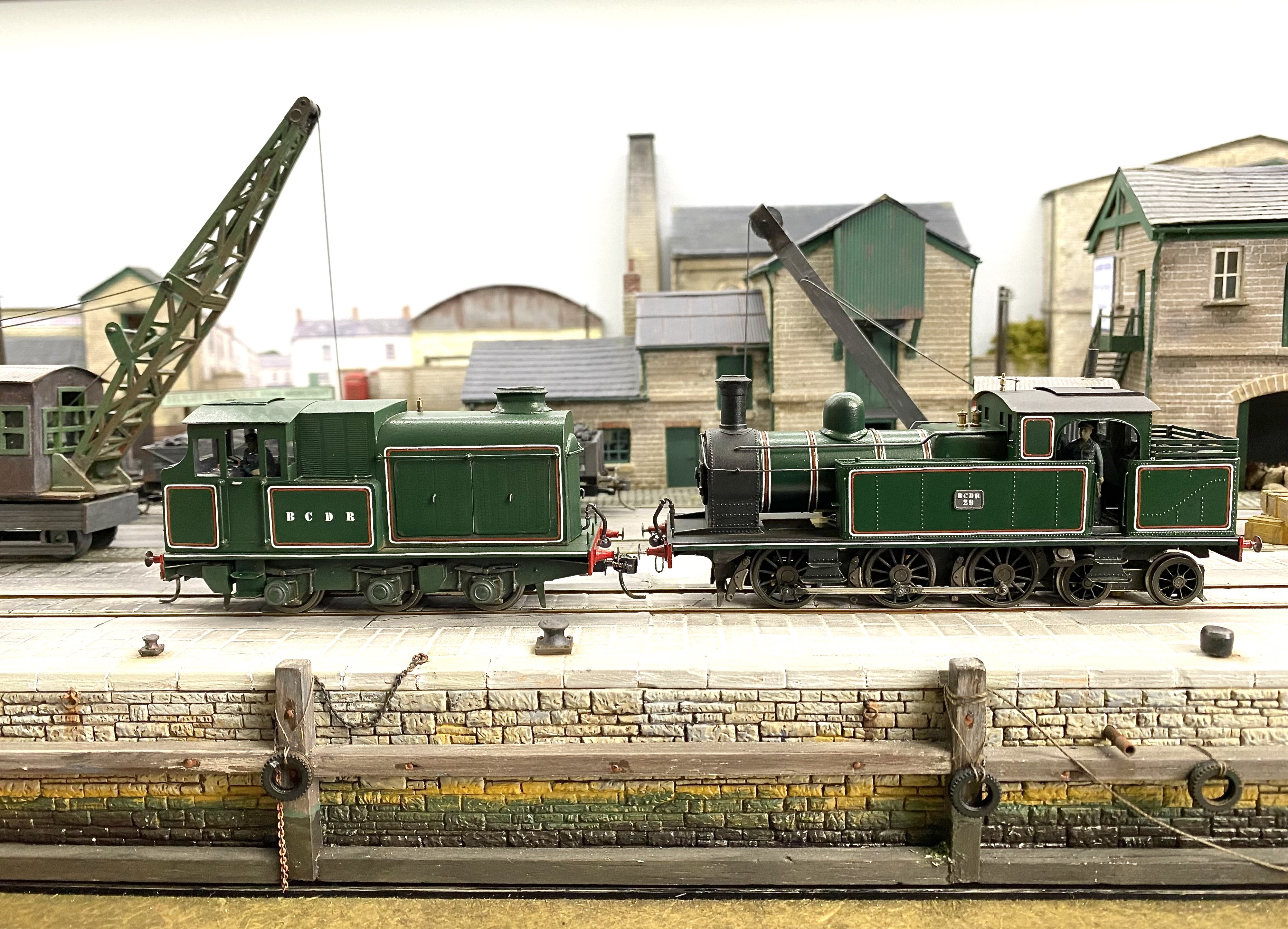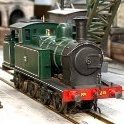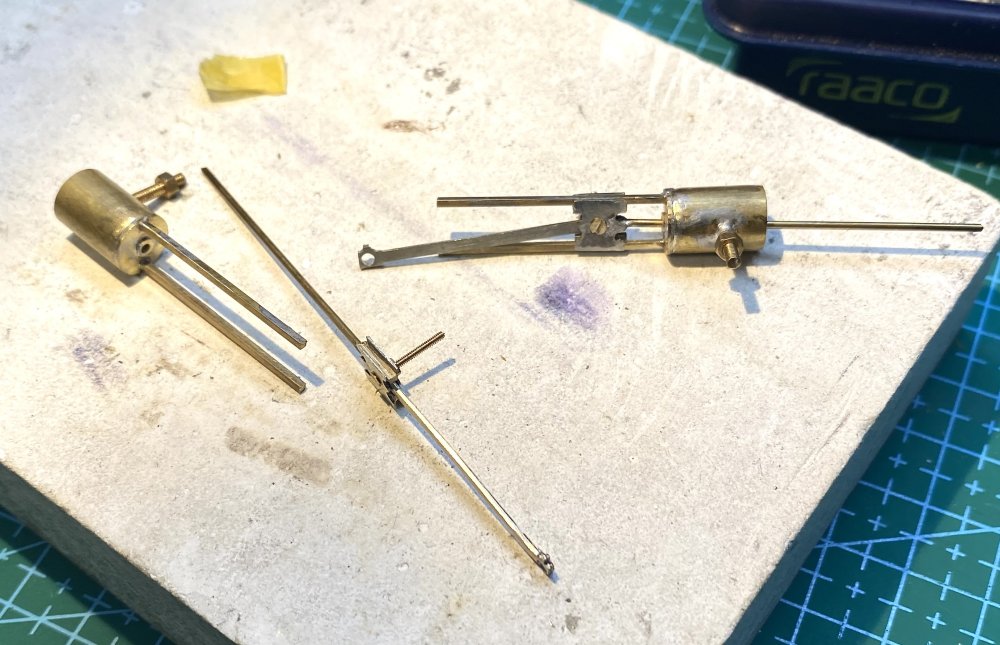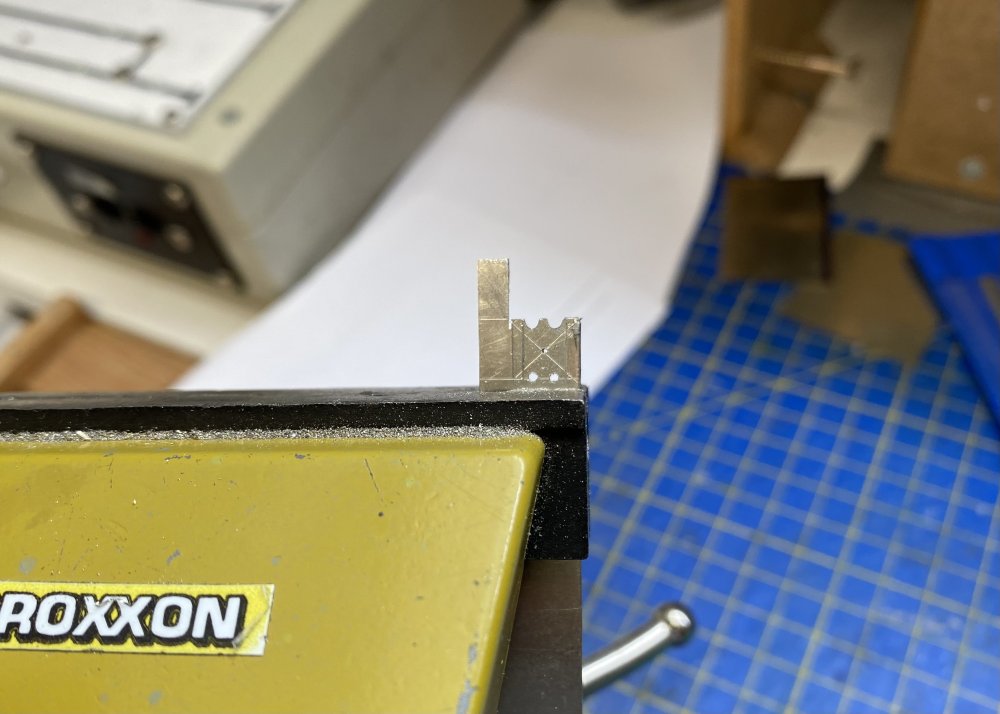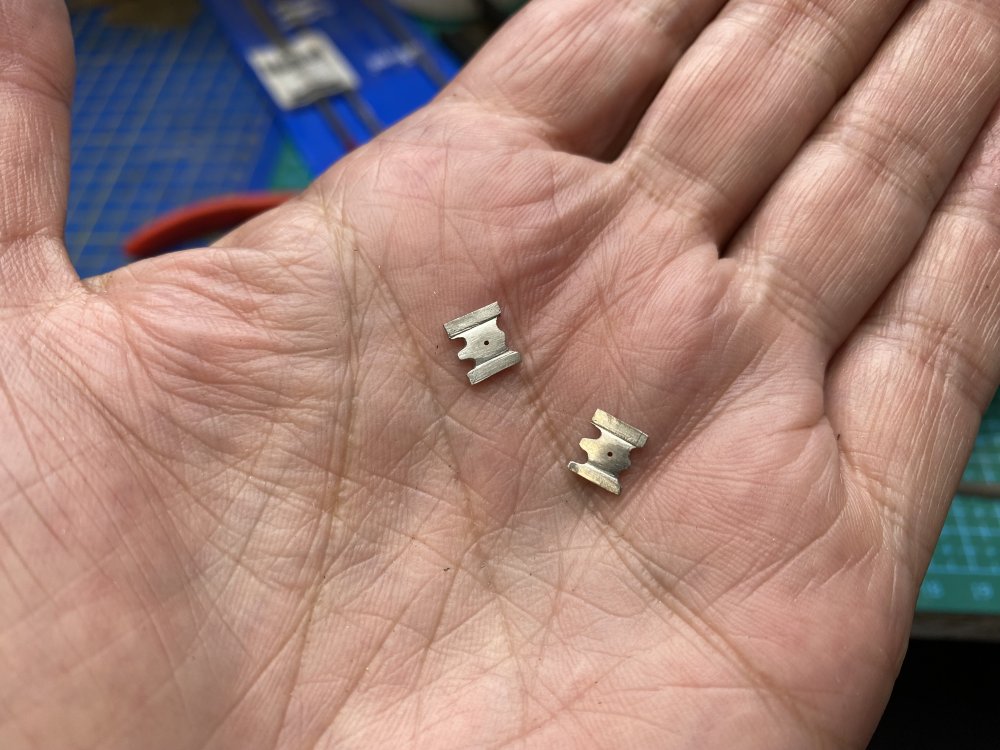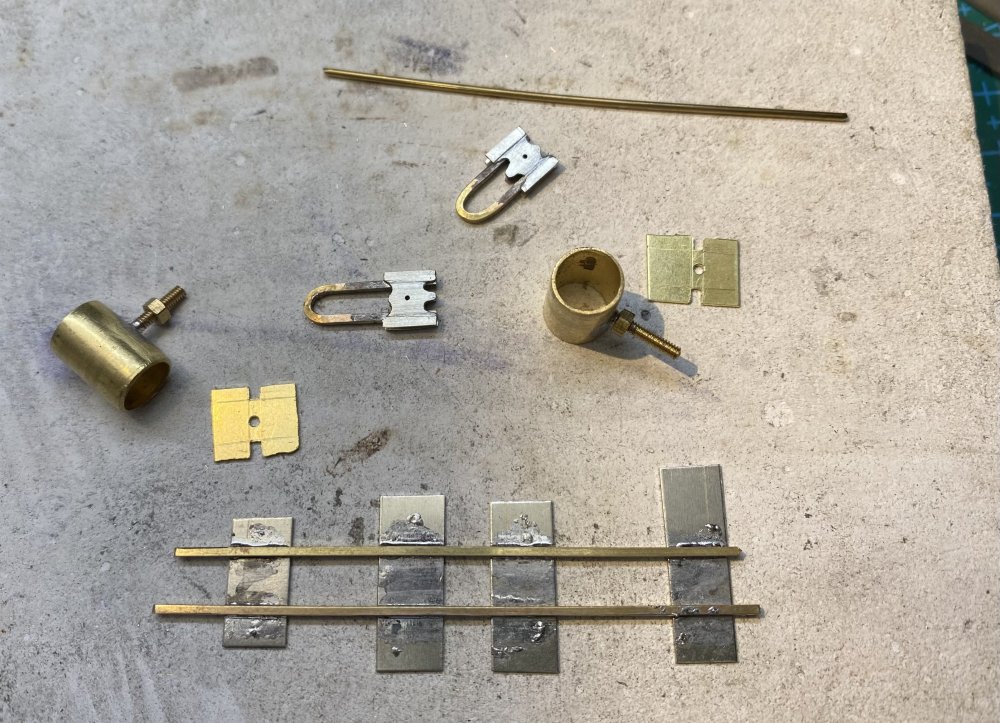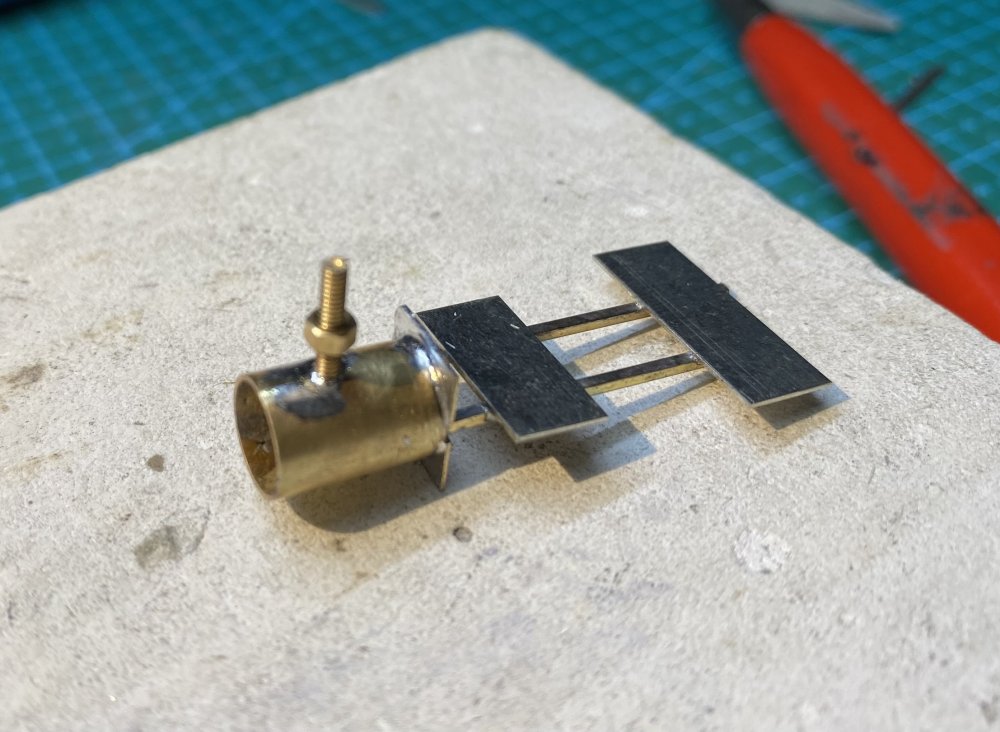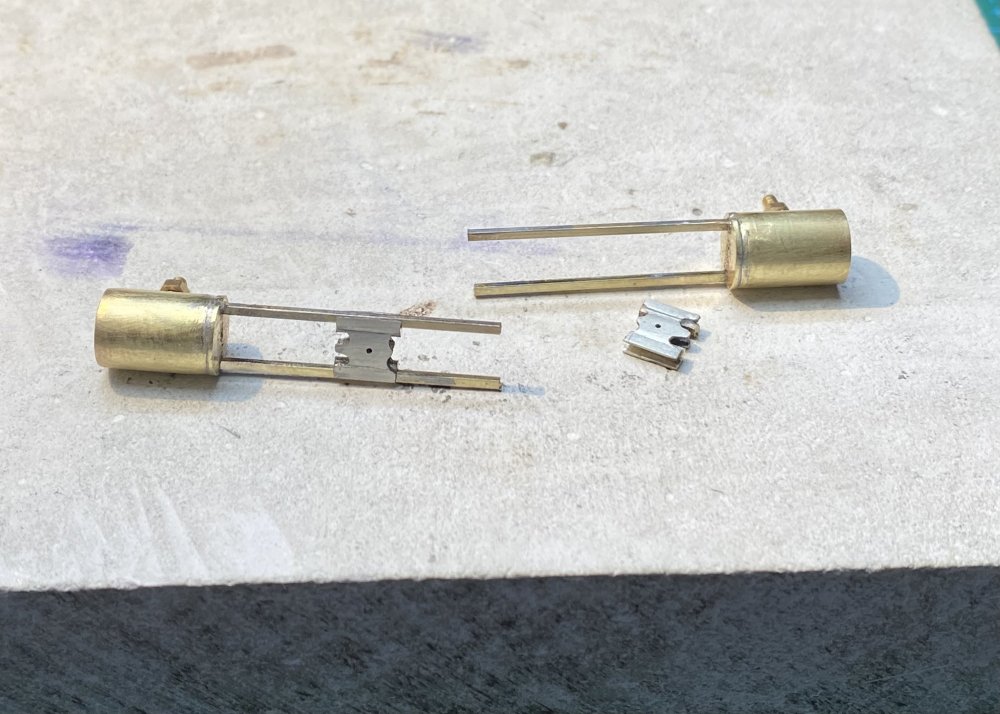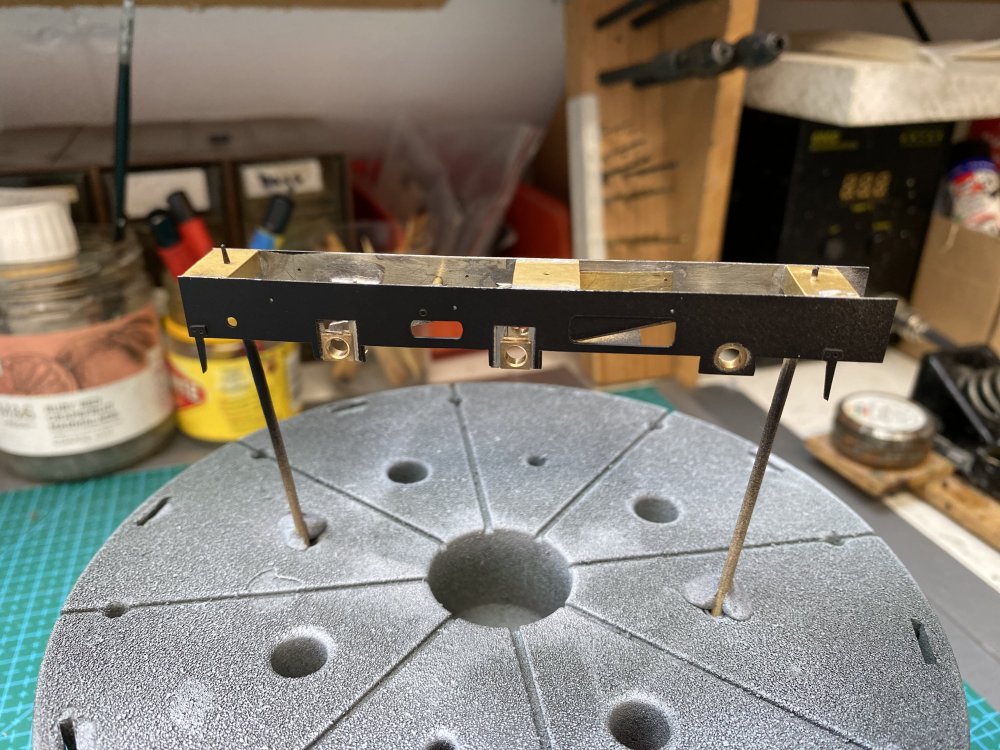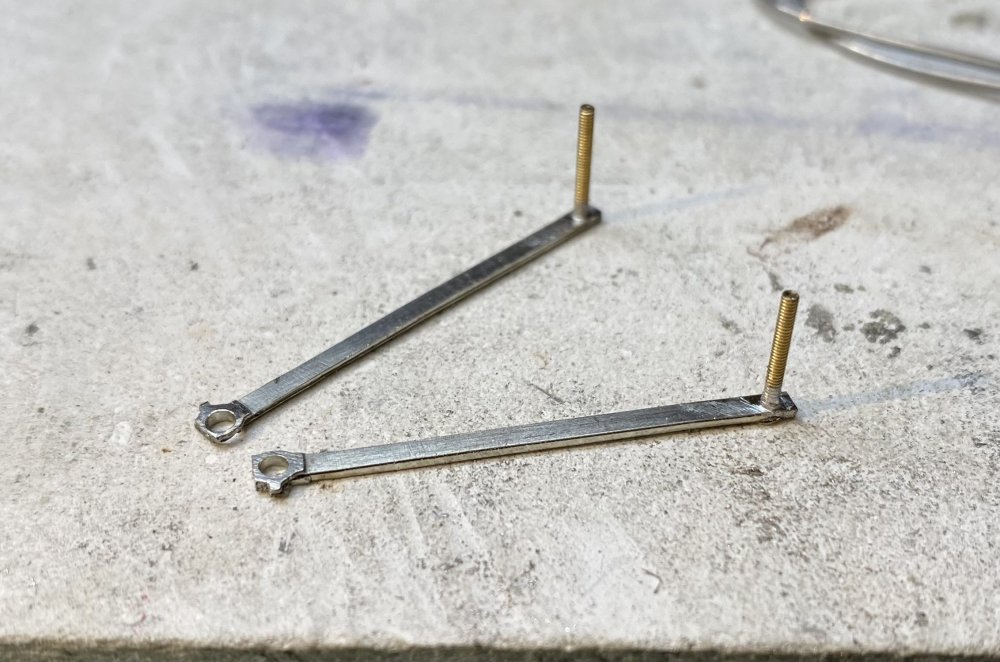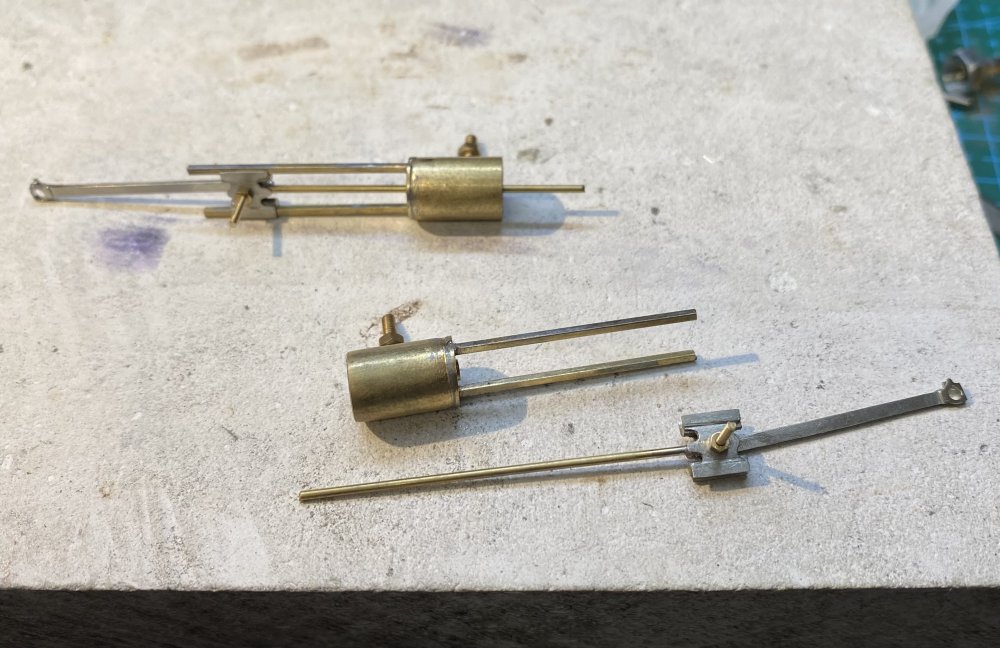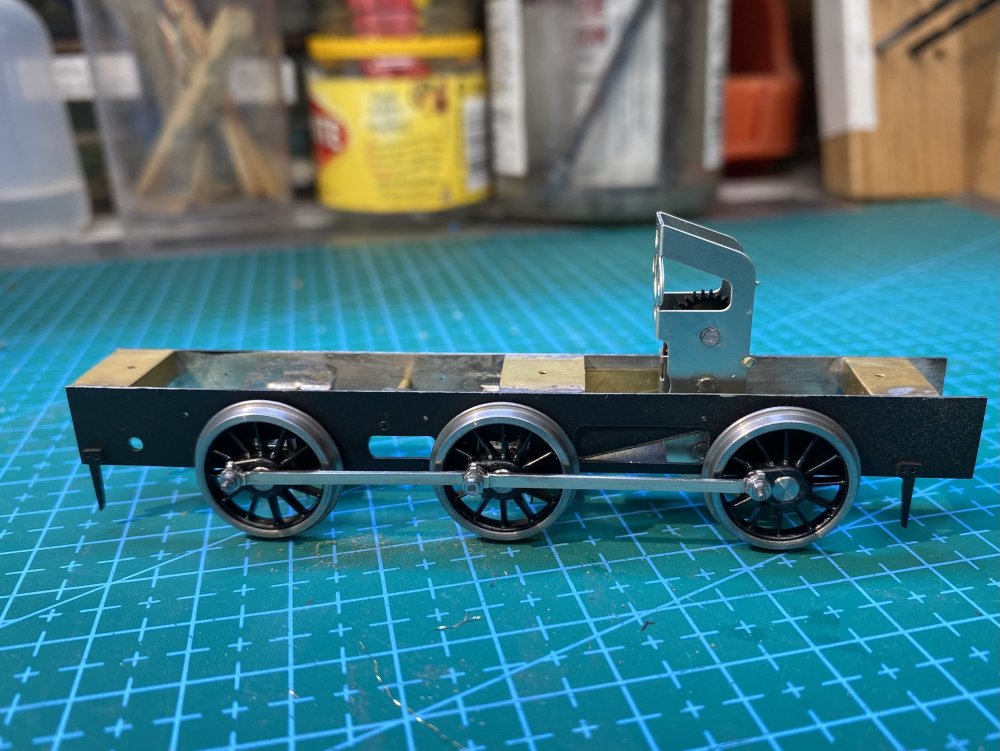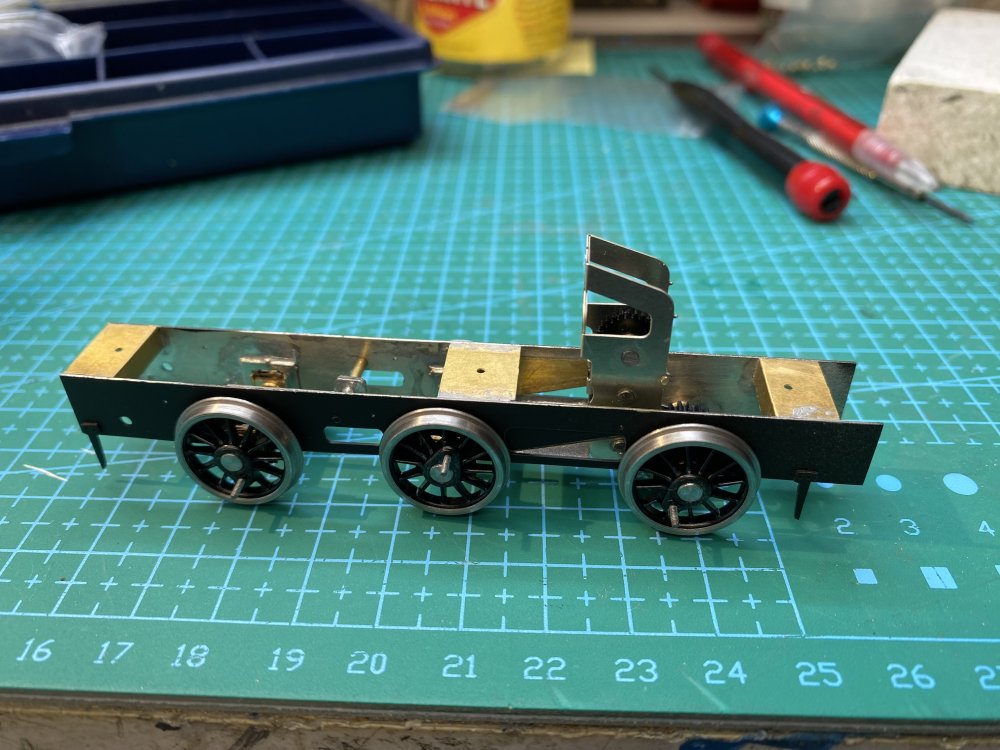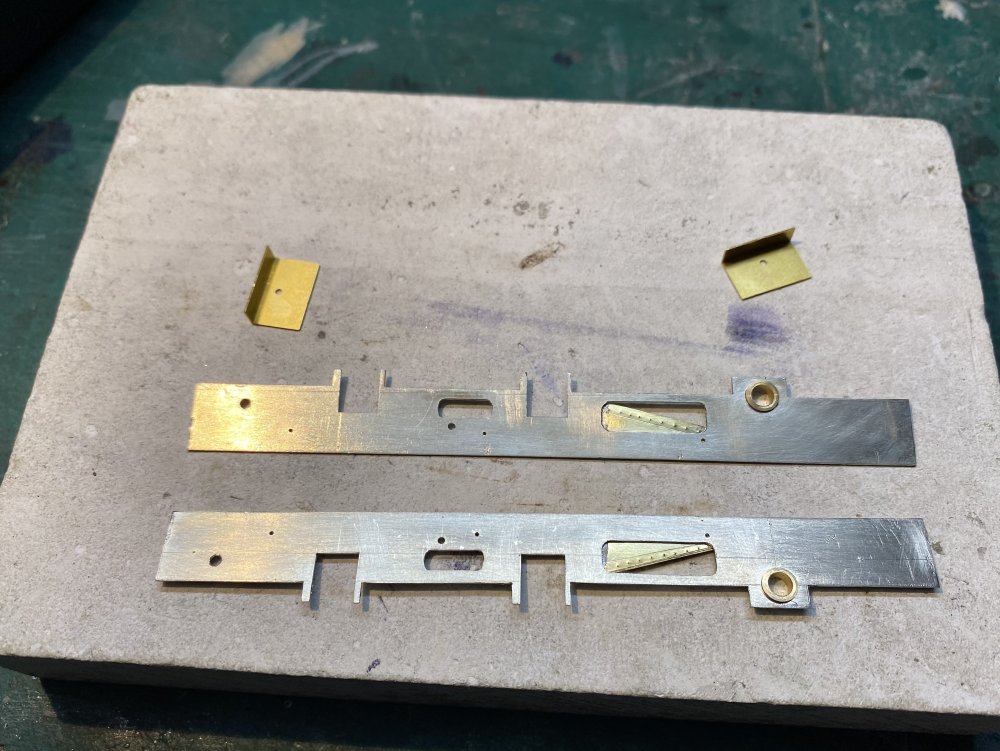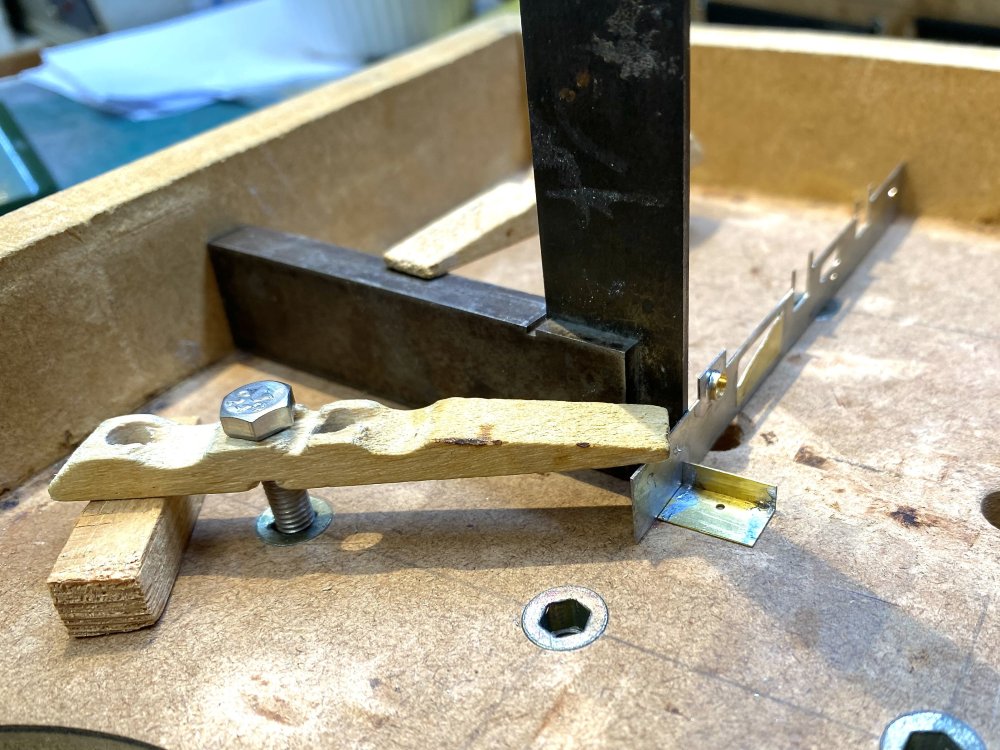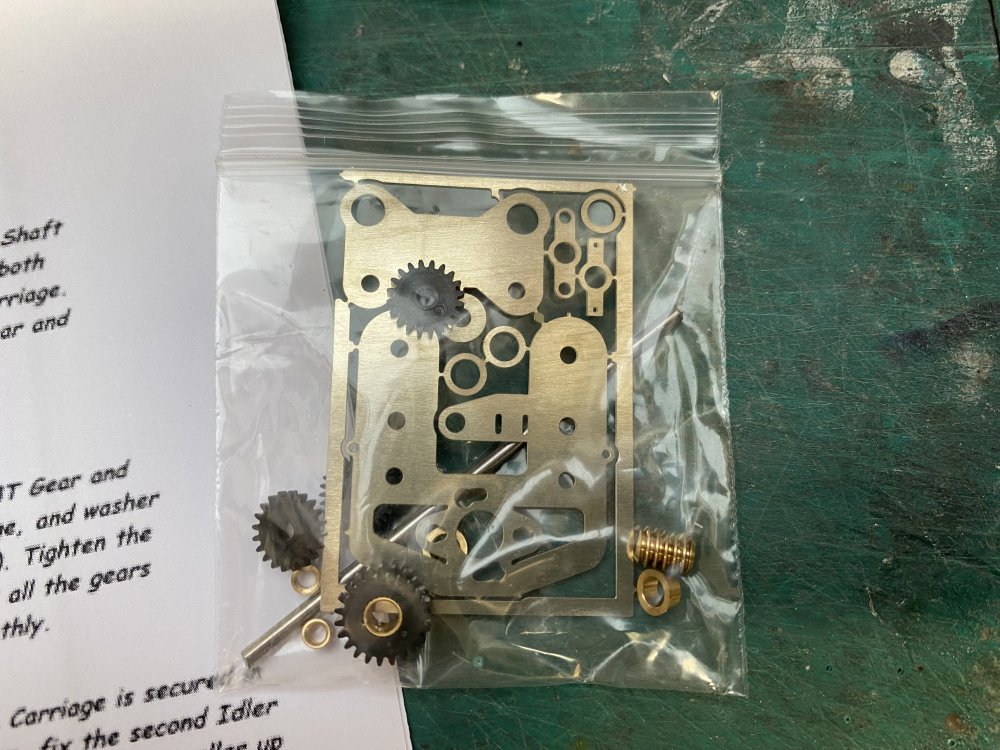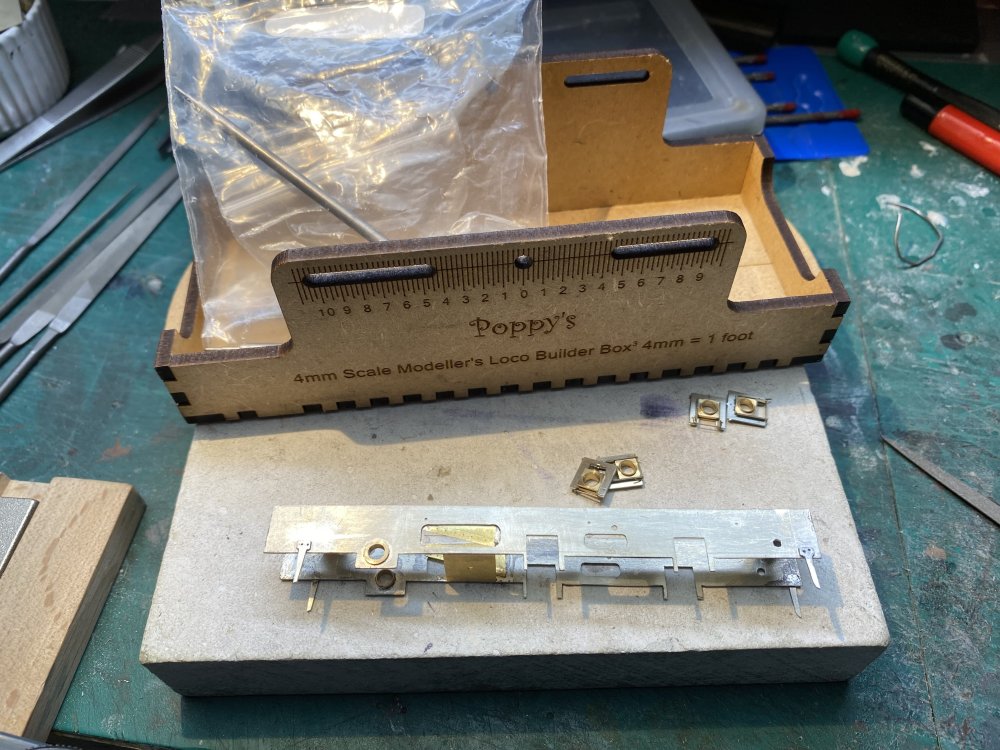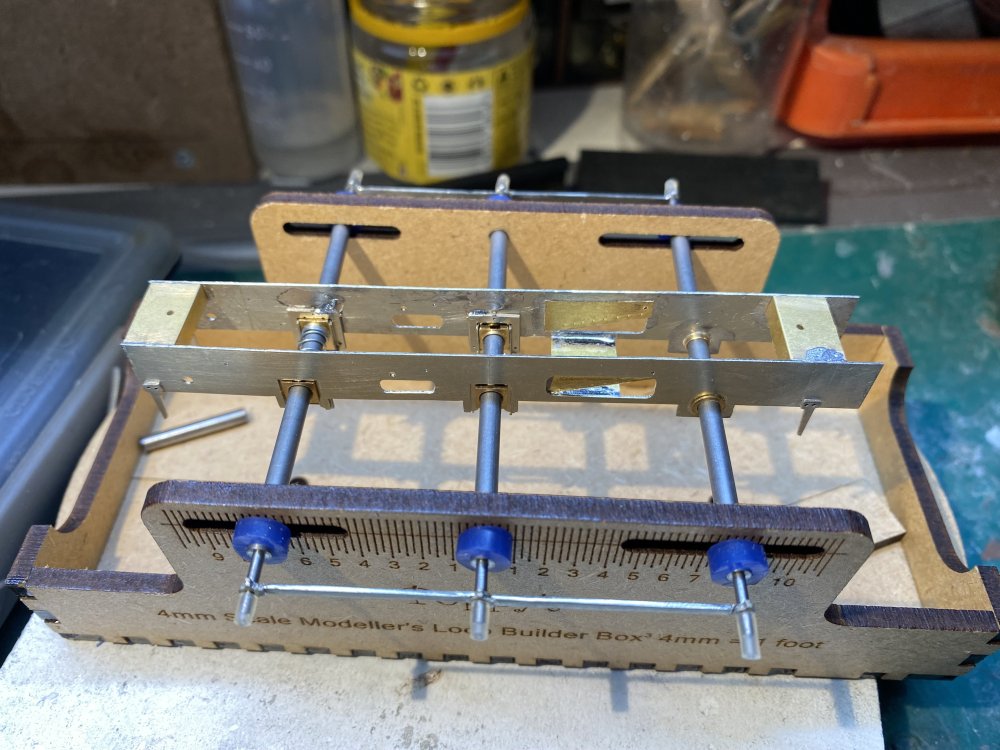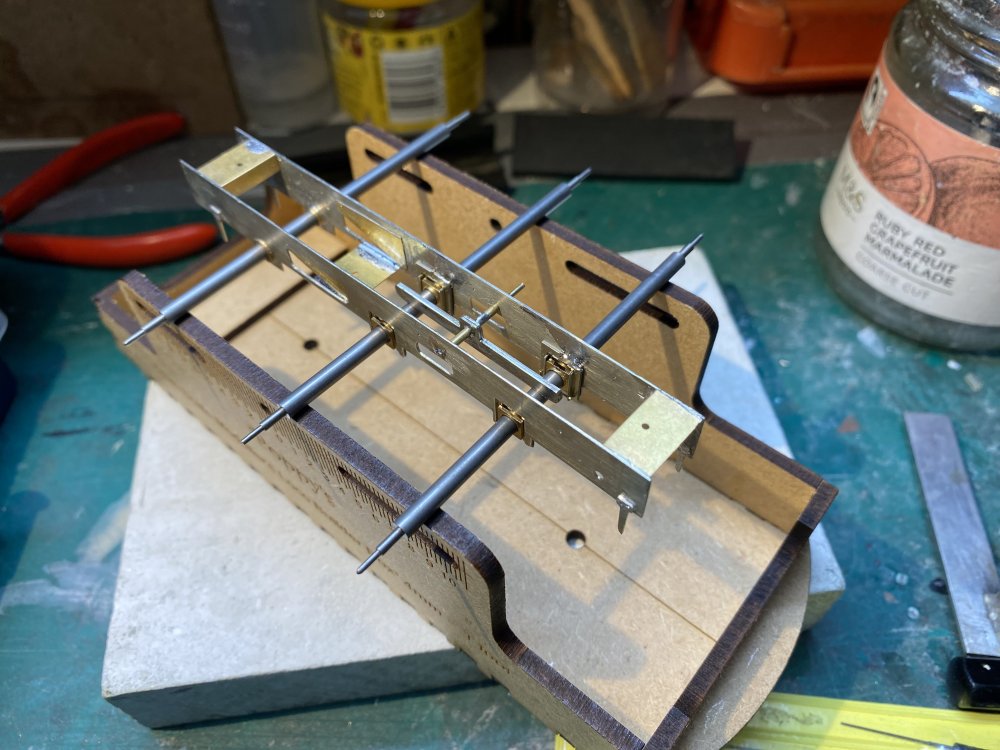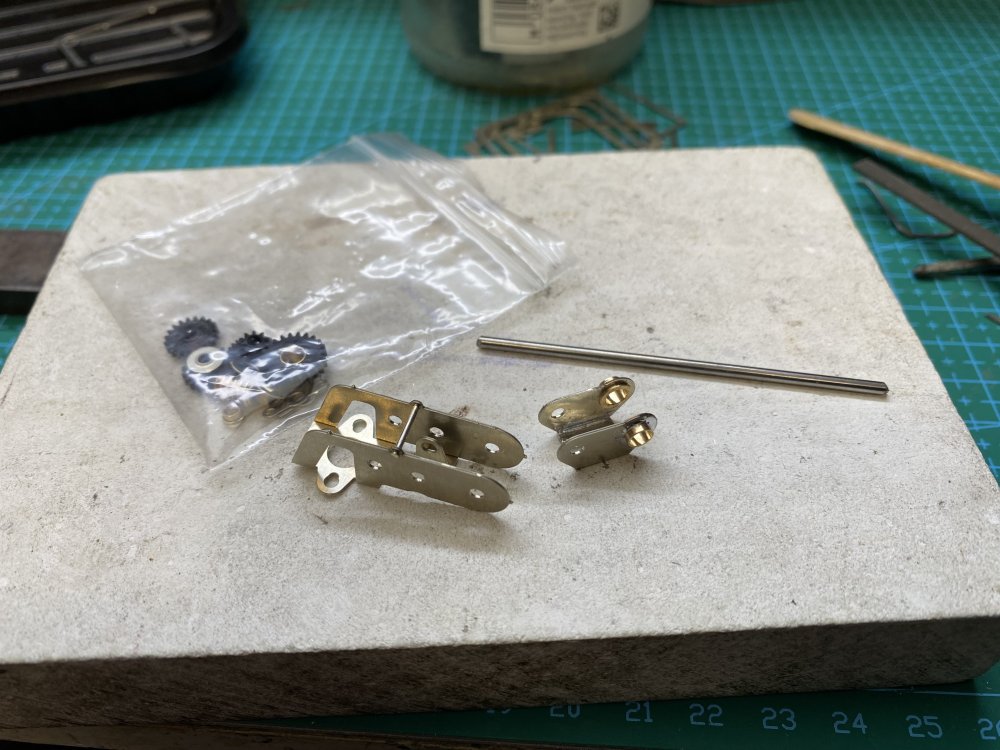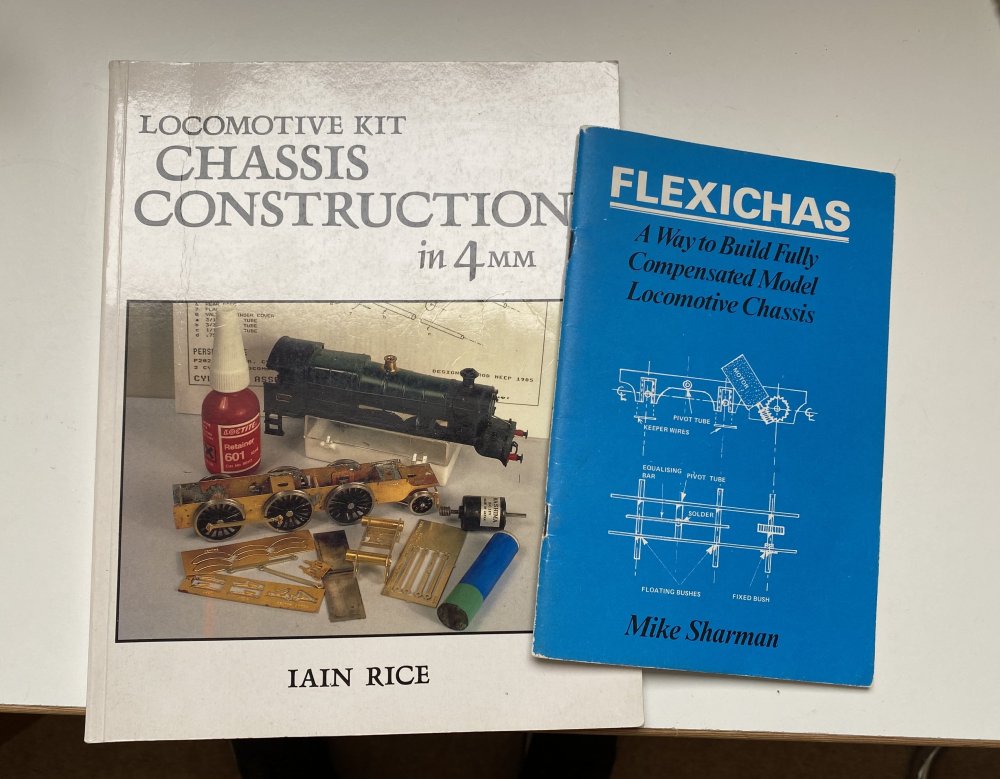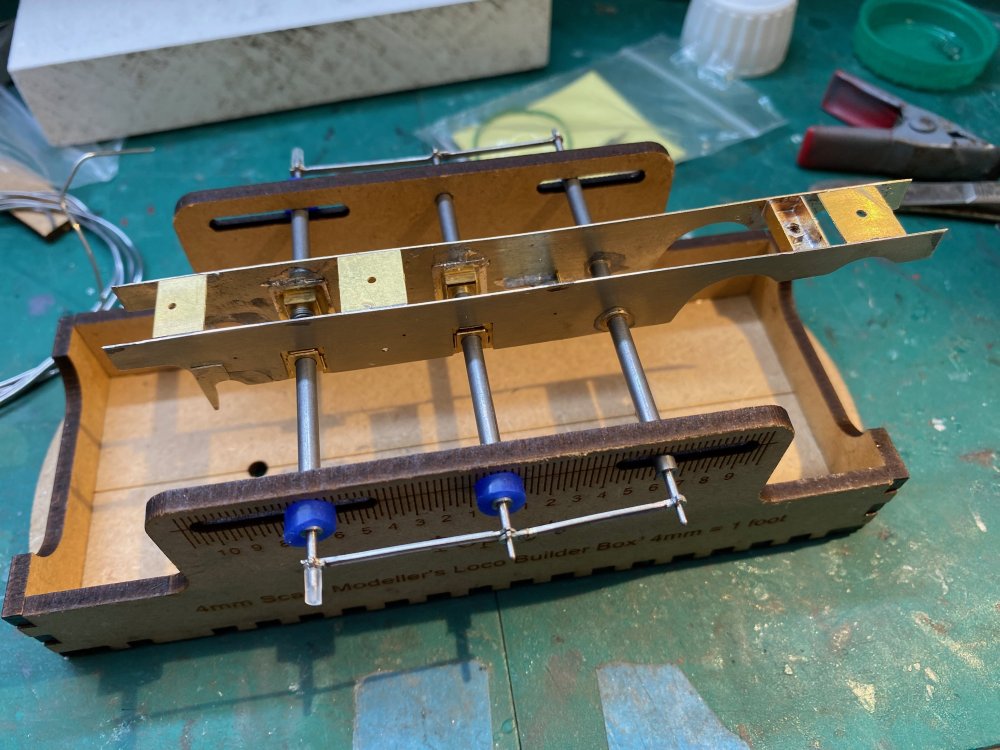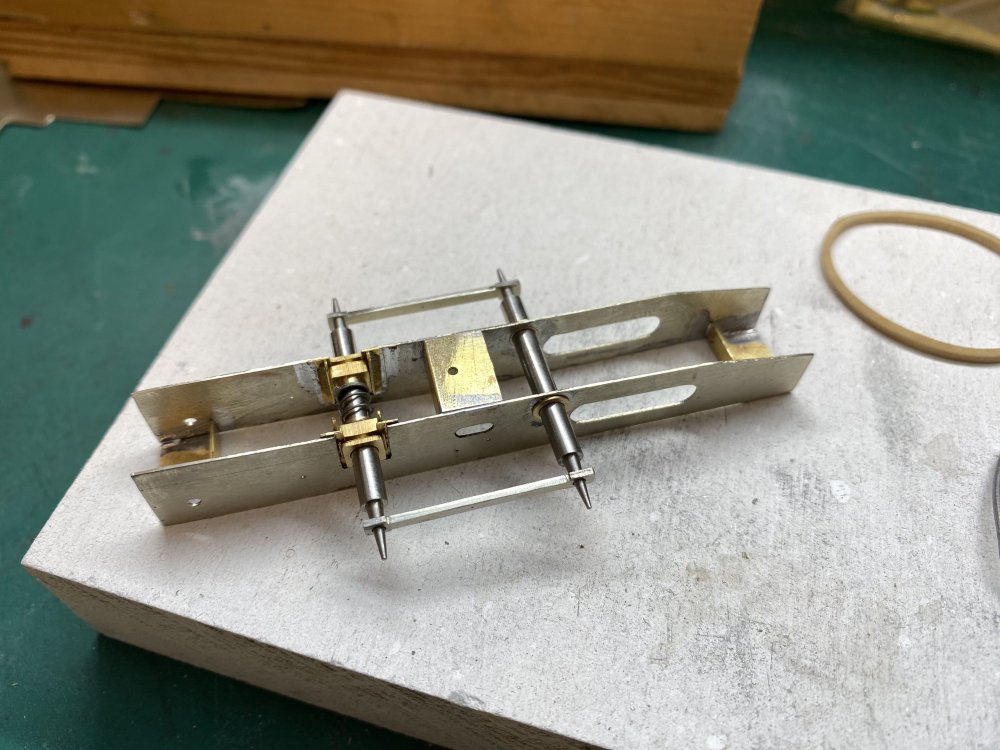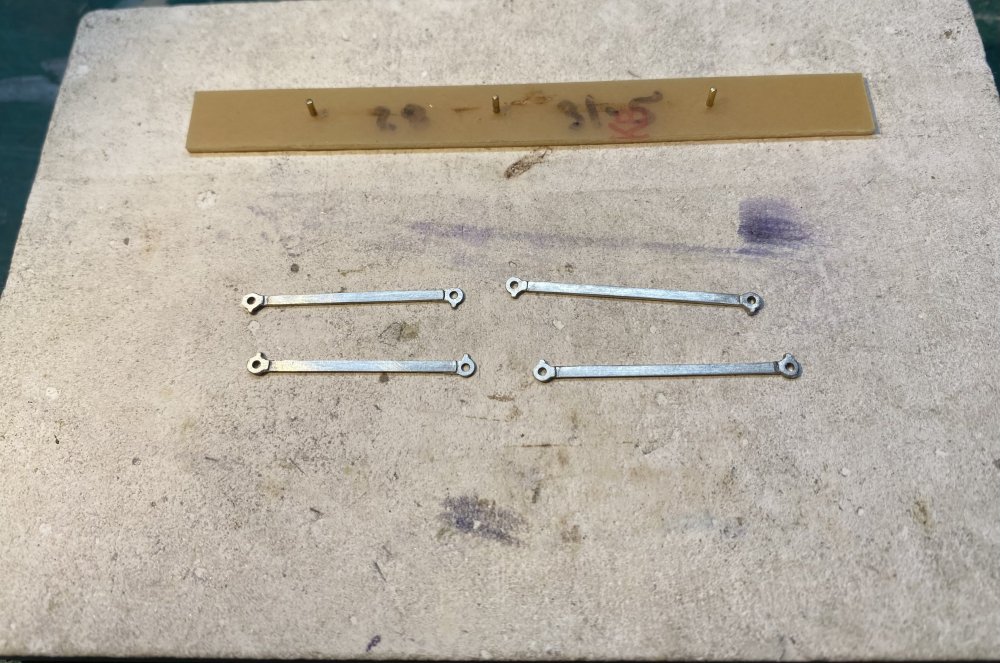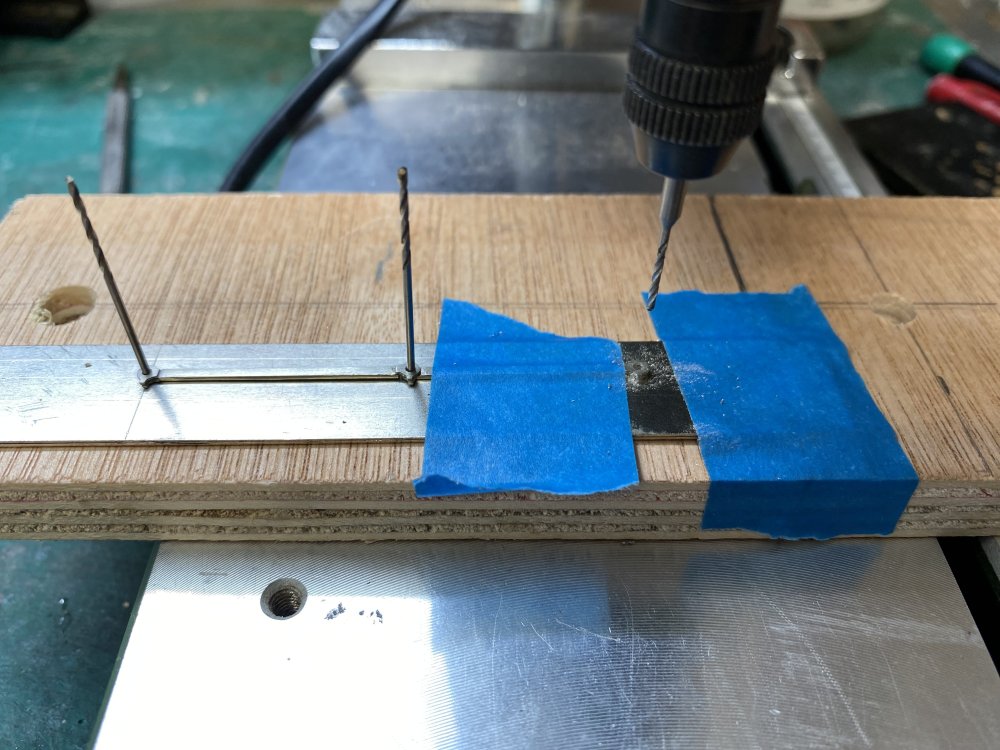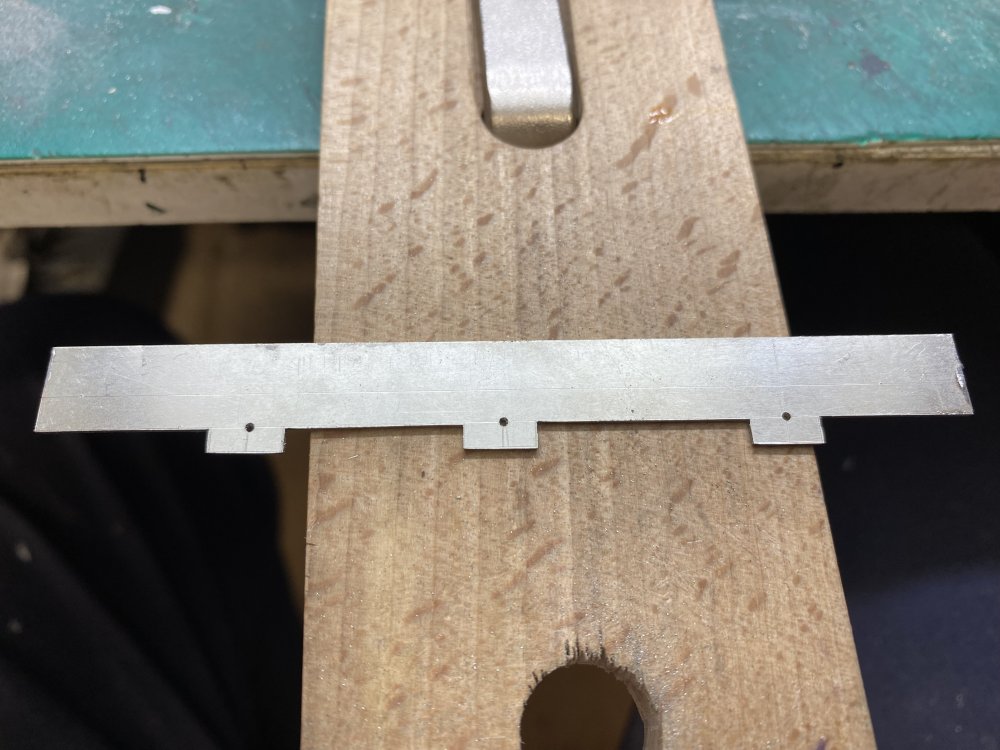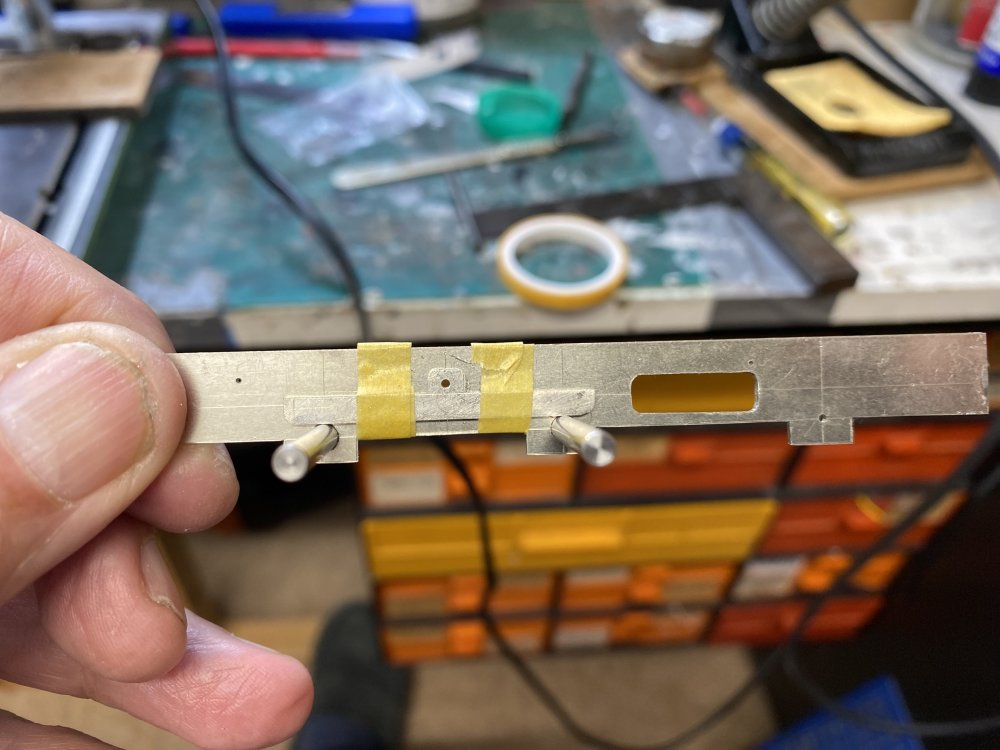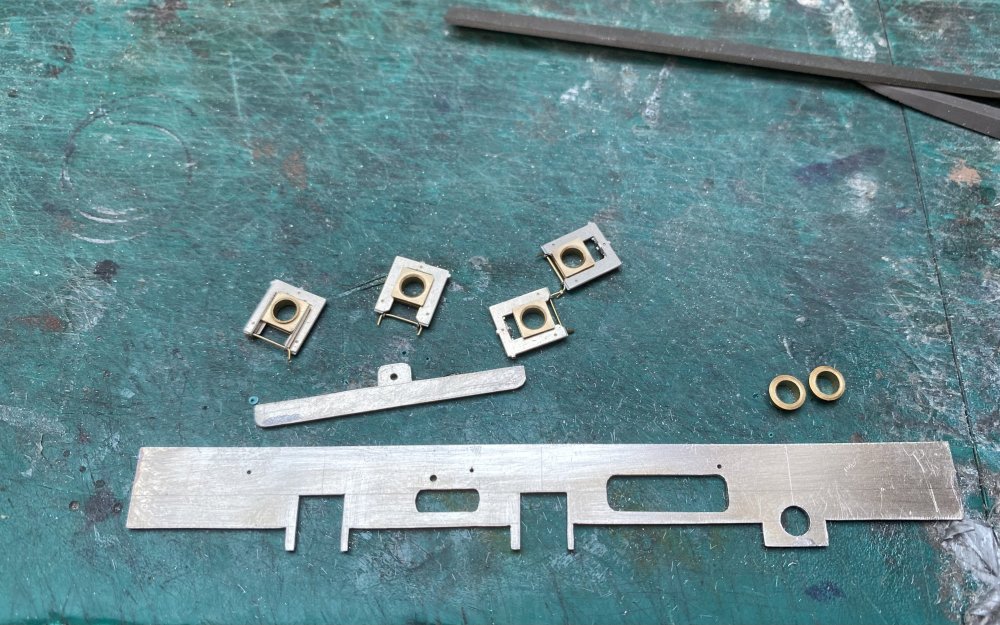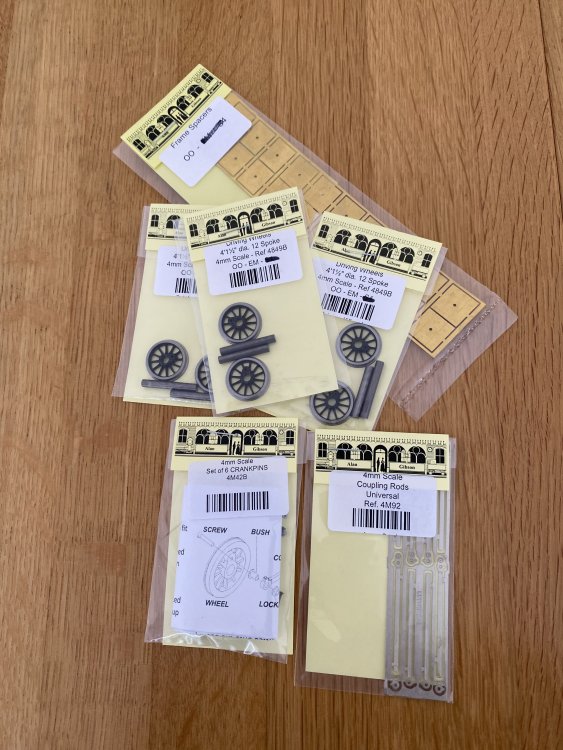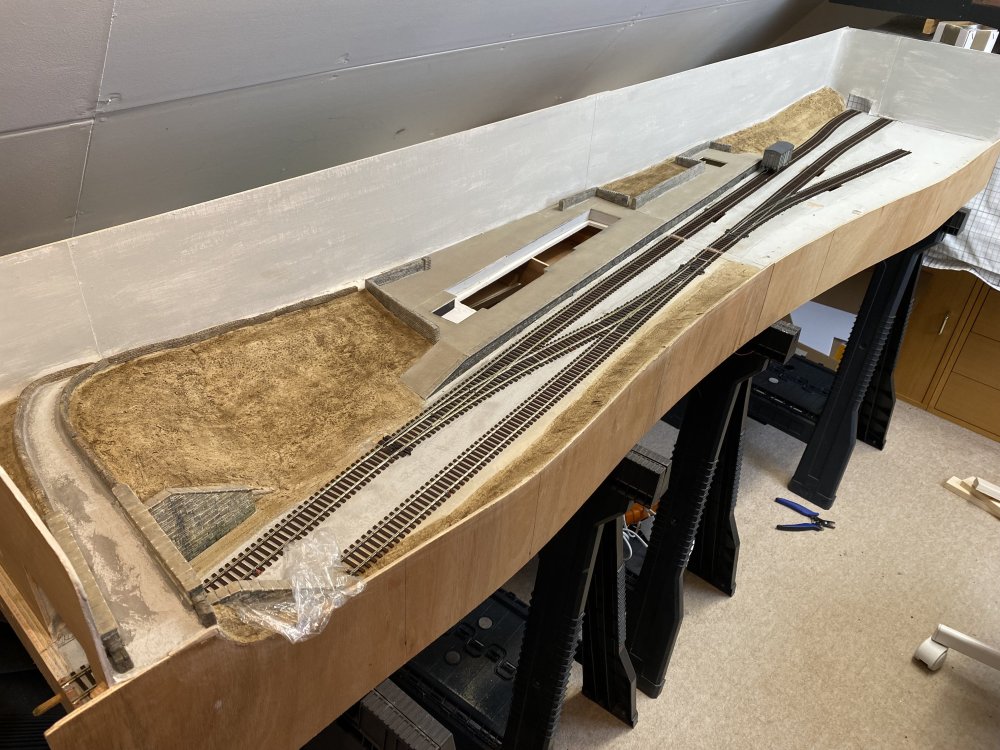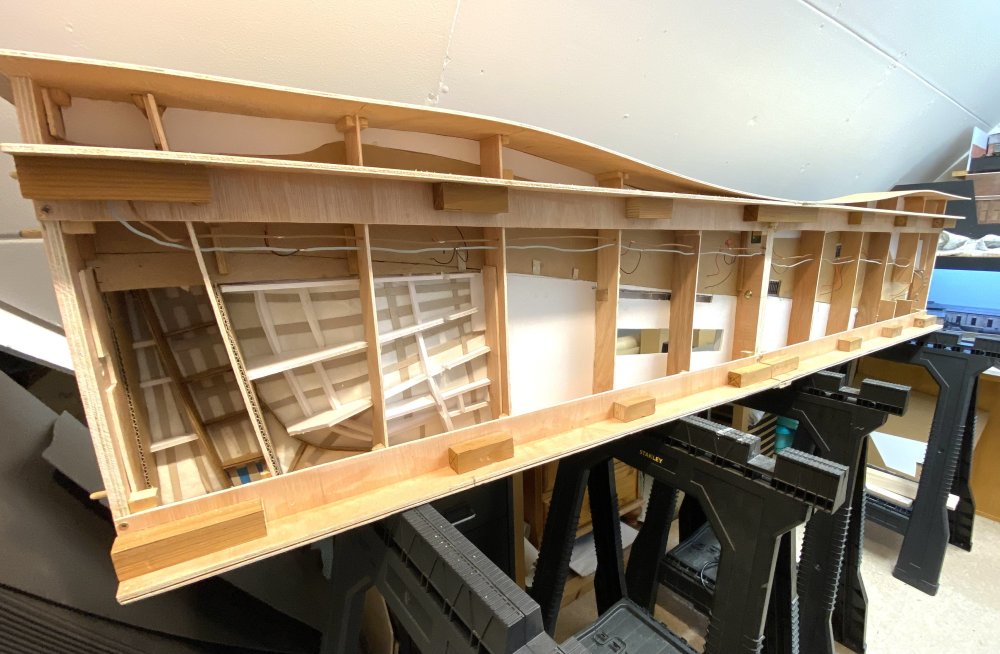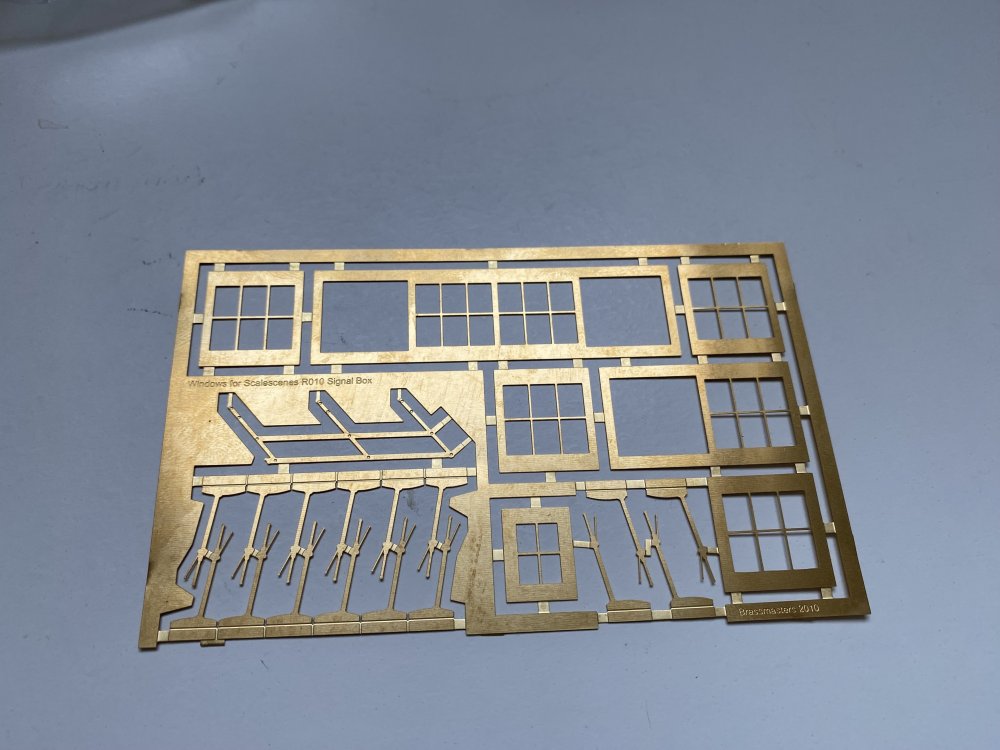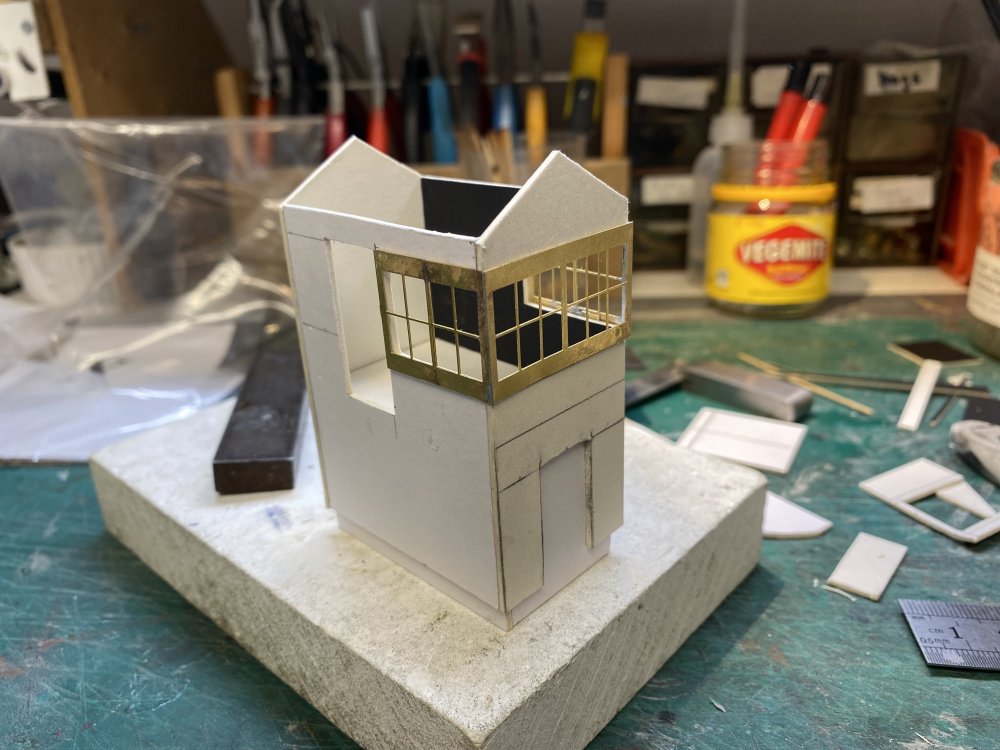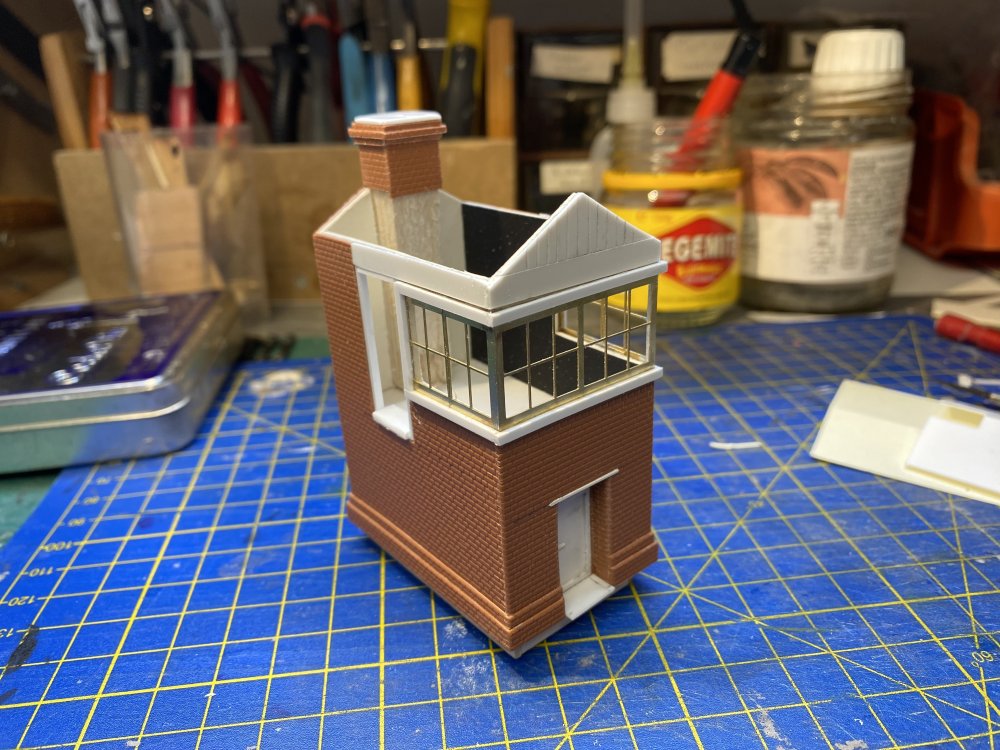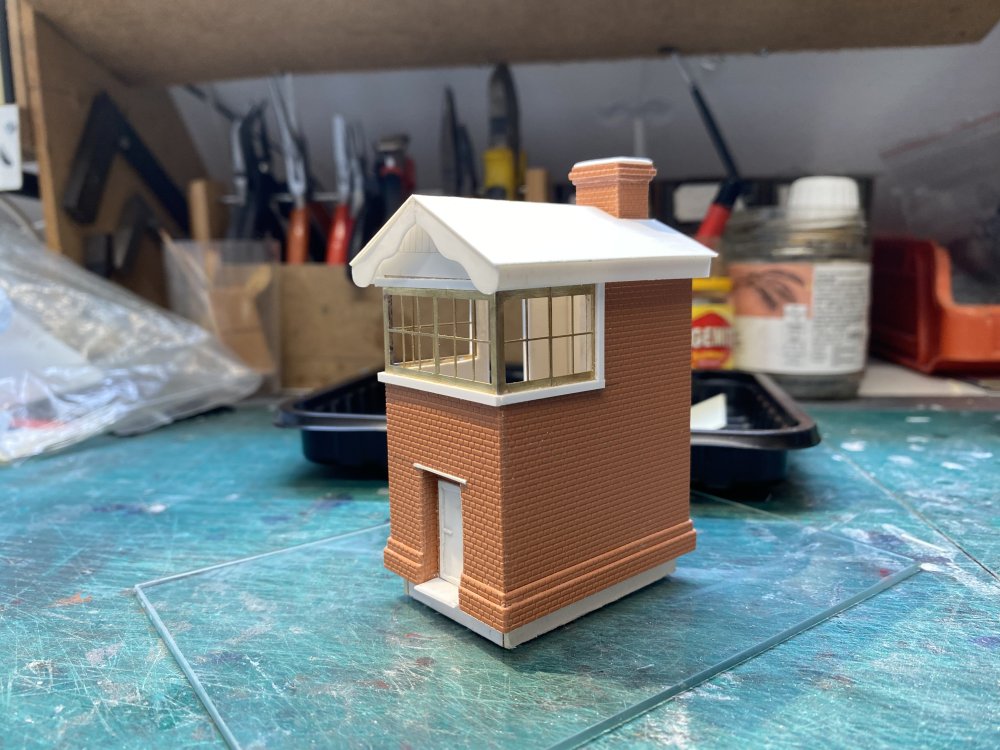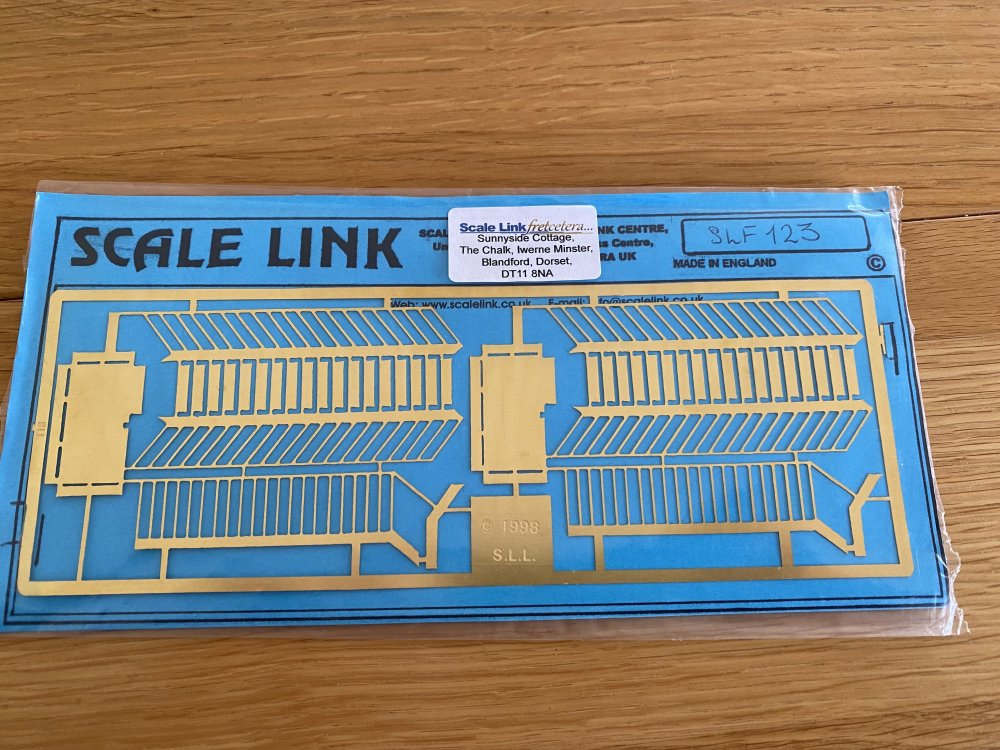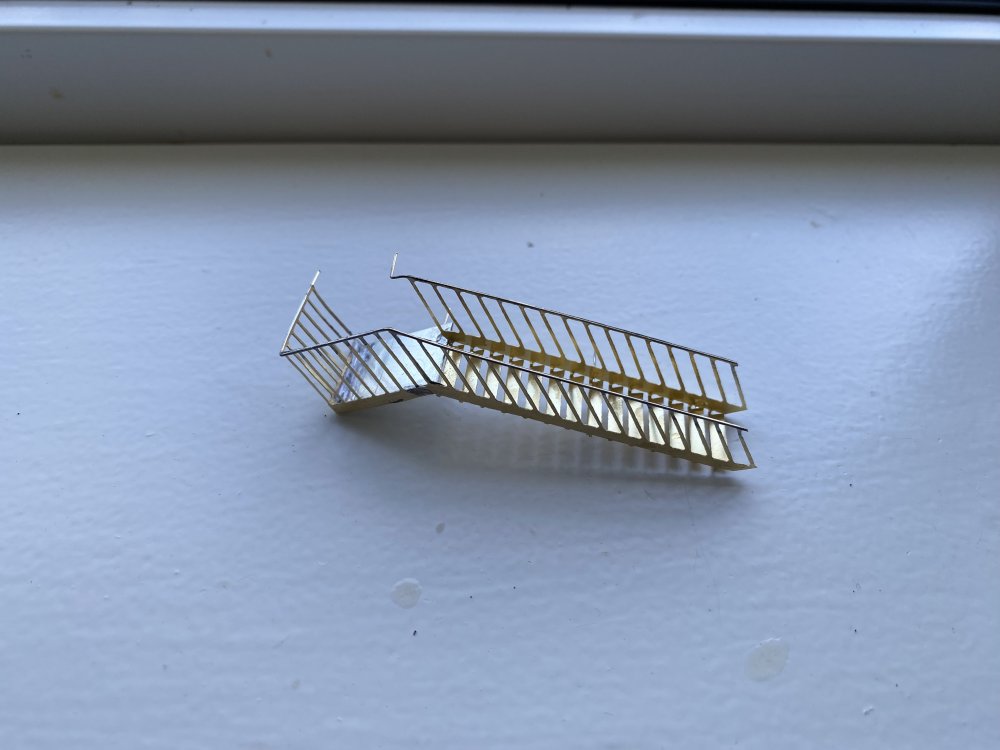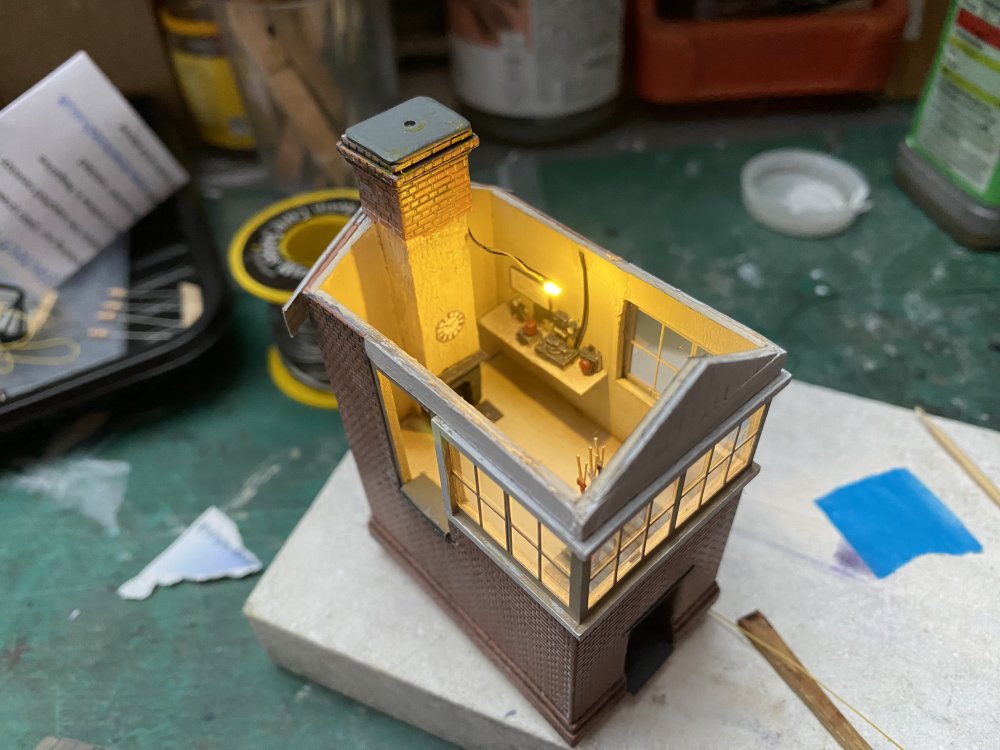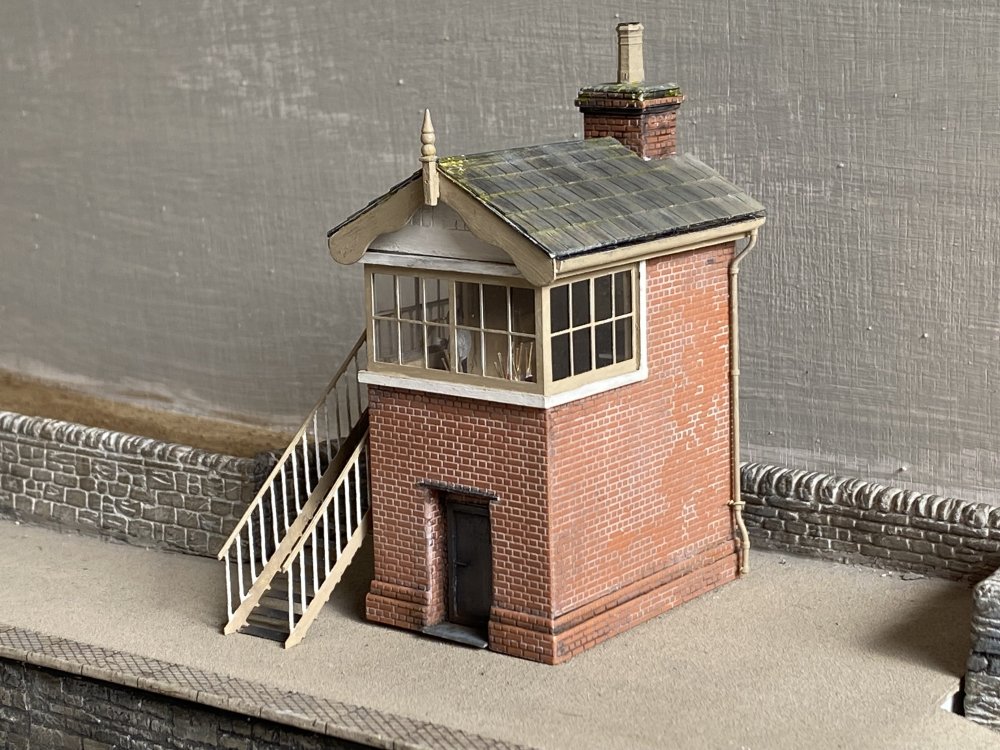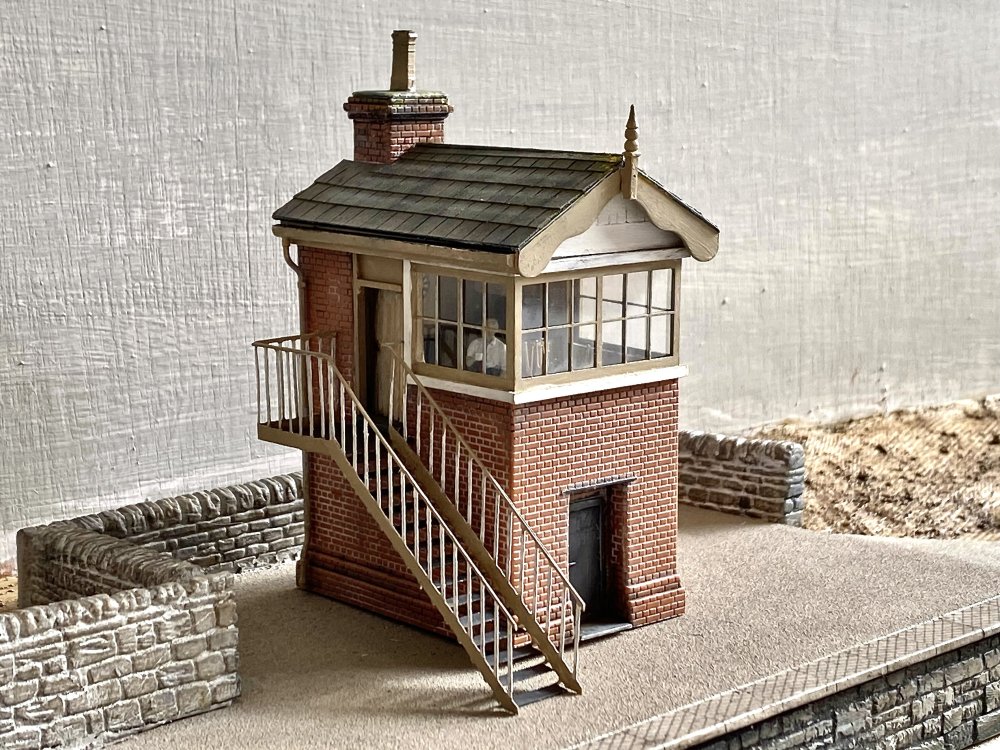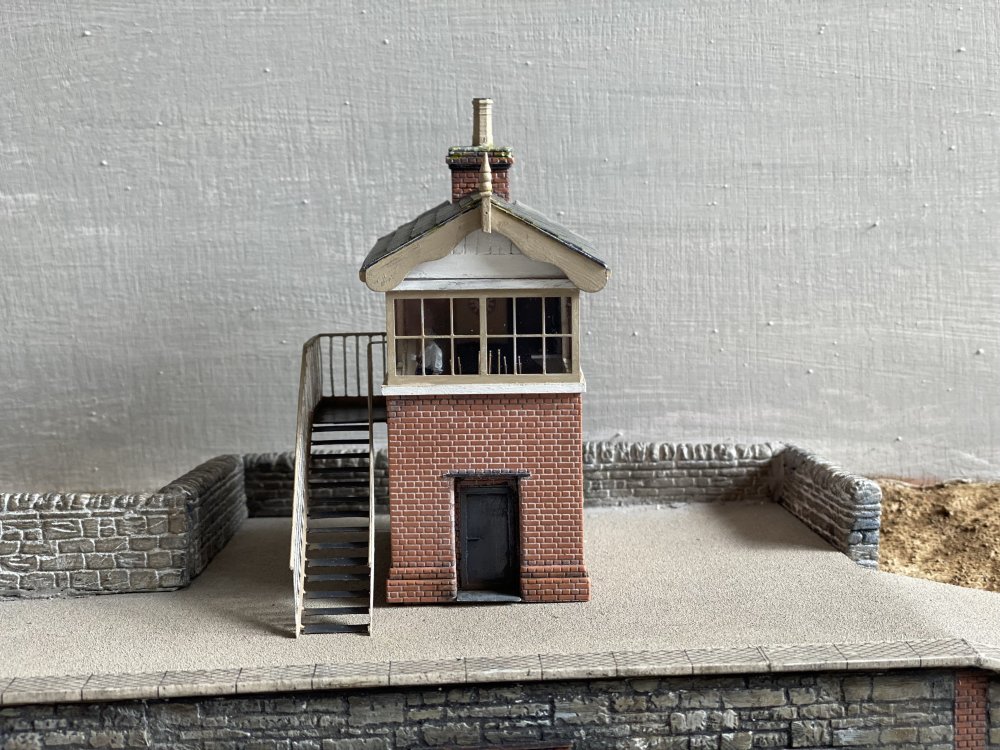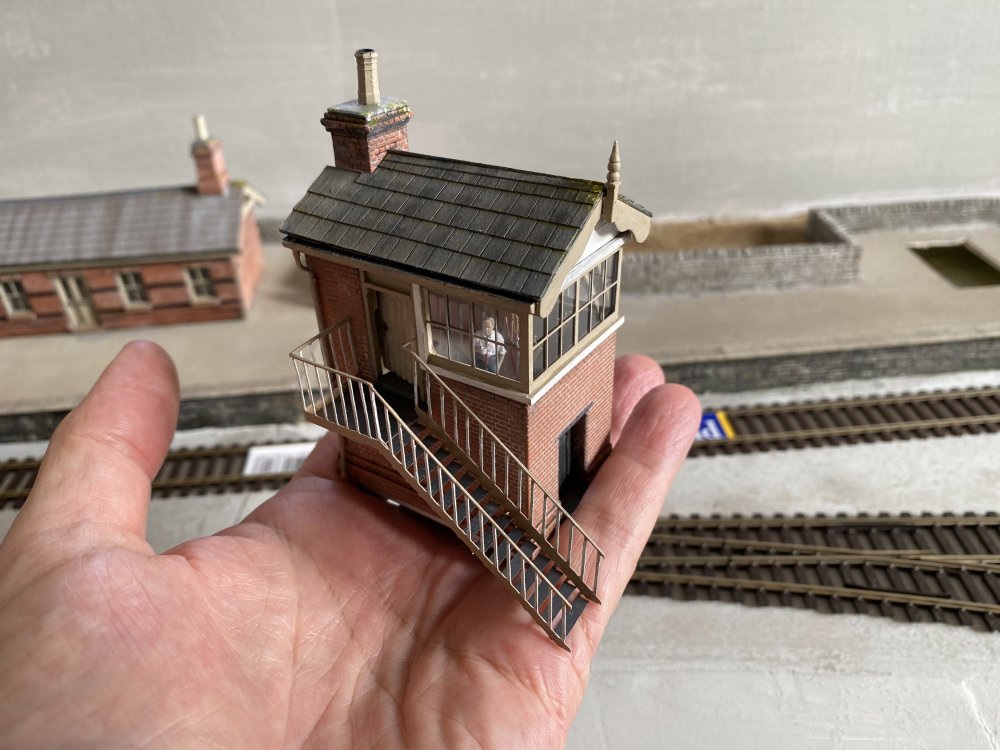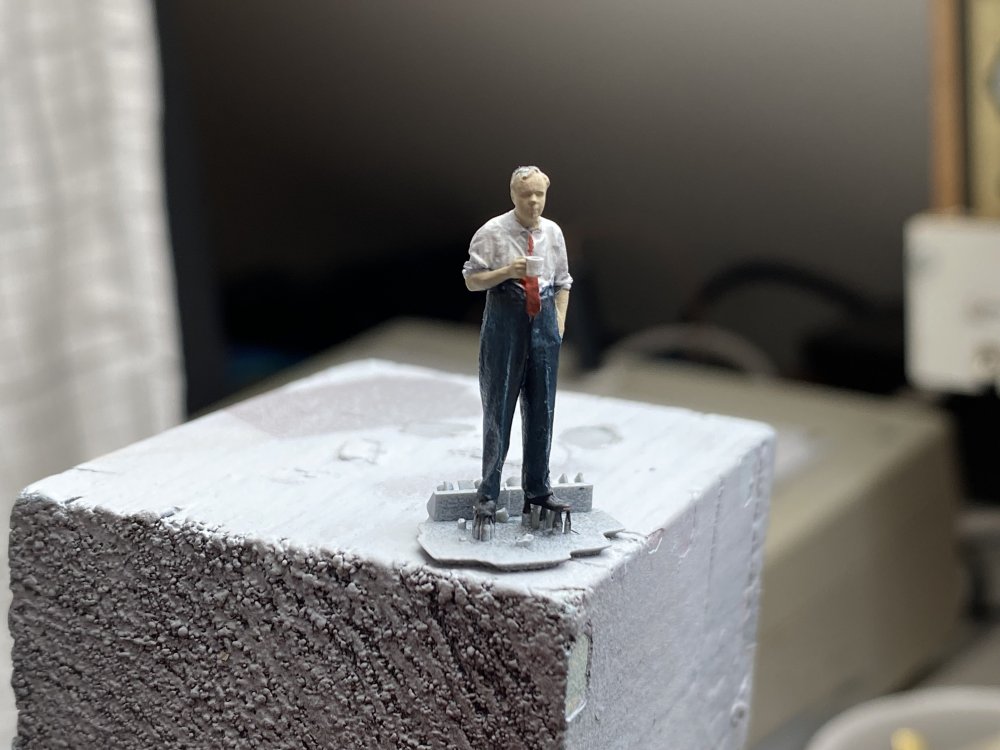-
Posts
957 -
Joined
-
Last visited
-
Days Won
56
Content Type
Profiles
Forums
Events
Gallery
Everything posted by Tullygrainey
-
Yes David. One of the attractions of modelling the BCDR too!
-
Since posting the above I've had a rethink about the crossheads, or maybe that should be I actually gave it some thought. Instead of bolting the connecting rod behind the crosshead, the end is now slotted into the space between the front and rear faces of the crosshead and a 14BA bolt run through both, thus creating a bit more clearance and making it less likely that the con rods will clout the crankpins on the front wheels. Got there in the end.
-
The Countess's chassis got a coat of paint before the wheels went on. It rolls nicely under finger pressure with no tight spots. Rods next, then an hour or two spent chasing a tight spot which predictably appeared when the last crankpin nut was tightened down. Just when I thought I was home free! The outside cylinders/slidebars/crossheads are probably the trickiest part of this build, both making them and getting them to work properly. I'm half way through that battle. Each crosshead was cut from two thicknesses of 16 thou nickel silver to get front and back matching. This is the kit of parts half way through the process. Cylinders from 8mm outside diameter brass tube, slidebars from 1mm square brass rod. The bits of scrap etch soldered to the slidebars are there to keep them equidistant until they're soldered into the cylinders. Connecting rods have a 14BA bolt soldered into one end. These go through the crossheads. Piston rods are 1mm brass. they'll be trimmed to length eventually. Now to unite cylinders with chassis and get the whole caboodle working. If I recall, it needs three hands. Alan
- 645 replies
-
- 12
-

-

-

-
That looks really well. A fine job on the lining. Can I ask what you used for that?
-
I'm a current member of the 7mm Narrow Gauge Association so I've just finished reading your original articles on the Association website. Inspirational stuff David! It's a great scale/format to work in, giving plenty of scope for flights of fancy as well as the considerable satisfaction to be derived from taking a ready-to-run model and making of it something completely new and original. You struck a very believable balance between prototypical reality and modelling imagination with that layout. And that oast house is a triumph of patience and perseverance, as well as a masterpiece to boot!
-
Didn’t notice the balance weights but the rods are certainly upside down
-
When you reflect on it, the range of materials and techniques available to us has expanded hugely over the last decade or two, perhaps giving the lie to the often voiced opinion that the hobby is in decline. Interesting, and exciting too, to speculate how things might continue to develop over the next decade or two. So long as it doesn't result in AI-driven 3D printers producing complete layouts in response to a sentence typed into a computer by the modeller. That would be the end of the hobby as we know it! Even then, I'd like to think there'd still be a few of us occupying our own little time warps, making stuff from raw materials.
-
Wonderful! Like your Irish layouts, it really projects a sense of place with its array of typical buildings. I think if I'd just seen the pictures unattributed, I'd have recognised it as your work.
-
Just perfect!
-
Some more progress on a chassis for the Countess of Antrim. Frames separated and ready to be assembled. Those funny triangles of brass shim are representations of the firebox, visible through the cutouts in the frames. I find getting the first frame spacer in straight and square is always a challenge requiring a number of goes and I haven't settled on a good way of doing it yet. It's all set squares and clothes pegs and verbal blandishments. Etched kits often have tabs and slots to help the parts go together accurately. No such refinement with these hand hacked bits! Spacers in, front, back and middle. Guard irons added. Ready for hornblocks. Poppy's jig does its stuff. Hornblocks in. Compensation beam fitted. A chassis sitting nice and level. Yay! The gearbox I chose for this one is a High Level HiFlier+. The etch is up to High Level's usual high standard - beautifully crisp - and goes together nicely, given bit of patience and care. The articulated final drive carriage means the motor can be pushed forward into the Countess's boiler leaving the cab free. A little jewel. IMG_2986.MOV
-
Looks good. Best of luck with this. I'll enjoy watching it develop.
-
Very important. A lesson I learned the hard way!
-
-
You're absolutely right David. The top of the hornblock cutout in the frame is the more critical one. The received wisdom is that it needs to be 4mm above the horizontal axle centre line. The width of the cutout is less critical. The High Level hornblocks I use are 5.5mm wide across the fences which guide the square bearing. I usually aim to make the cutout not less than 6mm wide, 3mm each side of the nominal centre point of the axle, to give me some wriggle room when setting up the chassis For setup, the connecting rods act as jigs to get the wheelbases right and the extra width in the cutouts allows each hornblock to be adjusted sideways as required. In this respect, it's a more forgiving process than building a rigid chassis. If you've drilled your axle bearing holes in the wrong place for a rigid chassis, it's difficult to correct it. Latterly I've used a Poppy's Wood Tech jig for setting up but the London Road Models jig axles work just as well.
-
I keep forgetting to look in this corner of the forum! An absolute joy to browse through all these images David.
-
Something not BCDR related for a change. Patrick @Patrick Davey's current project is a return to the narrow gauge Ballycastle Railway for a model of the halt at Capecastle. This time he’s modelling in 5.5mm/foot, allowing the 3 foot narrow gauge to be represented using Peco O-16.5 track. Working in 5.5m means the motive power and rolling stock will have to be scratch built or adapted from something else. My contribution to the project is a chassis for a proposed model of 0-6-0ST ’Countess of Antrim’, one of three saddle tanks built by Black Hawthorne for the opening of the line in 1879. We have a drawing which we were able to scale using a few known dimensions - wheelbase and wheel diameter principally. We also have some useful photos of the Countess in action and since no-one alive has seen the original, we have a degree of artistic licence to hide behind I'm building the chassis using 4mm/ft methods because it's what I know but the techniques should work well enough in the larger scale. The Countess was a fairly small engine. Likewise, 4mm parts fit the bill ok (as long as you're not a spoke counter). As usual, I started with the connecting rods and made these up from an Alan Gibson universal rods etch on a simple jig. The rods themselves then do duty as jigs to mark and drill 1mm pilot holes for axles on a pair of chassis frame blanks (16 thou nickel silver) This chassis will be compensated so a compensation beam was next (2 thicknesses of 16 thou nickel silver), with the axle pilot holes opened up to accept a pair of axles so the beam could be positioned touching the axles and the pivot hole drilled through the frames in the right place. A bit more cutting and filing to accept hornblocks (High Level SpaceSavers) and the frames are almost ready to be separated. Alan
- 645 replies
-
- 12
-

-

-

-
Nice solution to a perennial problem!
-
Great pics and that weathering is totally convincing.
-
Track is now laid, wired and tested on Kilmore's scenic boards. Droppers are 7/0.2 multicore wire. The bus wires are single core copper mains lighting cable. I used to lay the track then fit the droppers but now I solder these to the rails before they go down. Far fewer melted sleepers this way. Phono plugs and sockets take care of inter-board connections. Track on the scenic section is Peco OO Code 75. The non-scenic bits are a mix of Peco and Hornby Code 100. The whole layout footprint is now 11 ft by 6 ft. The only place I can set it up without throwing furniture into a skip is the garage. Putting it all together allowed all the connections to be tested and some tweaking of the track ends at board joins. Some of the locos needed a bit of encouragement too. Of the BCDR stock, diesel No.2 is finding the 4th radius curves on the linking sections a challenge and sits with its wheels spinning with more than two or three wagons in tow. More weight needed maybe. The 0-6-4T dock shunter No.29 derails on these sections and will need a bit of work to make it behave. The rest of the stable manages ok. 2-4-2T No.7 happily pulls 2 coaches, 12 wagons and a brake van. Video of some of the first runs... Kilmore first runs.mov A way to go yet but we're making progress. Alan
- 121 replies
-
- 17
-

-

-
Great pictures of the layout and the venue David. Thanks for sharing. A wonderful place. It's been on my list for a visit for a long time!
-
He's a home bird really.
-
Tullymurry was a small station on the BCDR main line a short distance from Newcastle. Its signal cabin was compact and unusually (uniquely?), built gable end on to the line. I used it as the guide for this signal cabin for Kilmore. Having never built one before, I studied form at @Patrick Davey's Brookhall Mill and Clogherhead. Thanks Patrick. Construction is mainly embossed plastic card over a mounting board carcass with some etched brass providing bits that would be difficult to make from scratch. An etch from London Road Models provided the basis of some window frames after a bit of cut and shut. The London Road Models etch also provided the bits for the lever frame... ... and an etch from Scalelink Fretcetera gave me some outside steps. Can't imagine trying to make these from scratch. Signal cabins really need at least a semblance of internal detail and this is my semblance. Don't look too closely at all the gubbins on that shelf. I've no idea what they are except that they were left over from one of Patrick's signal cabin builds. He wasn't sure what they were either but they look the part. From a distance. The tiny LED isn't as yellow as it looks in the pic. Signalman from ModelU. I think he borrowed the tie from that bloke who's always in the news. And just about done. This thing is minuscule! I've been putting off laying track on the scenic boards. Running out of excuses. Alan
- 121 replies
-
- 15
-

-

-
Some very impressive hand-built track there. The buildings aren't bad either! Lovely stuff.
-
Thank you David. Sometimes it's better to leave things as they are but the niggles about this one just wouldn't go away. The original roof was done with hand cut strips of light card. The new one is built up with ready made laser-cut strips from York Modelmaking. Not sure what material it's made from but it's flexible and tough and yes, it is probably thicker than the card I used before and certainly more regular in appearance. It's also self adhesive and takes paint readily. To simulate the ridge tiles, I glued a length of 1mm brass rod along the ridge and butted strips of the York Modelmaking stuff up tight against it on both sides. I replaced the gutters and downpipes with smaller diameter rod and changed the colour to match the station building. The lichen was done with artist's acrylic, titanium white and cadmium yellow, applied with a fine brush and also the tip of a cocktail stick. Alan
-
Largely forgotten pioneer of rubber band propulsion for model railways. Cobley’s company was known for its resilience and was briefly successful during the inter war period but a shortage of raw materials from the plantations in Malaya after the second world war stretched the business almost to breaking point. The hoped for bounce-back never happened and the company was eventually erased.
.png.c363cdf5c3fb7955cd92a55eb6dbbae0.png)
